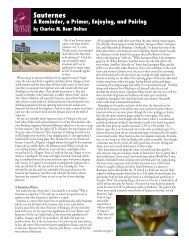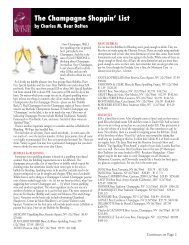What I Tasted on My Spring Break - SPEC's Liquors
What I Tasted on My Spring Break - SPEC's Liquors
What I Tasted on My Spring Break - SPEC's Liquors
Create successful ePaper yourself
Turn your PDF publications into a flip-book with our unique Google optimized e-Paper software.
www.specs<strong>on</strong>line.com<br />
(c<strong>on</strong>tinued from p. 13)<br />
has an almost California style, due to ripe blackberry fruit with lots of cedar and tobacco and even pencil shavings, al<strong>on</strong>g with dusty gravelly terroir notes and<br />
a healthy dose of oak. Some of this style extends to the lesser siblings Clerc Mil<strong>on</strong> and d’Armailhac. I tend to like the less expensive d’Armailhac better as a<br />
barrel sample and for the first five or so years after the vintage than its sibling Clerc Mil<strong>on</strong>. After five or so years, Clerc Mil<strong>on</strong> seems to pass d’Armailhac and<br />
c<strong>on</strong>tinue to develop. To me, d’Armailhac has more power and fruit while Clerc has more elegance and balance.<br />
In 1926, a large part of the famous Pauillac sec<strong>on</strong>d growth Ch. Pich<strong>on</strong> L<strong>on</strong>gueville was sold. The new property was called Ch. Pich<strong>on</strong> L<strong>on</strong>gueville Comtesse de<br />
Lalande and is now widely known as Pich<strong>on</strong> Lalande. The unsold porti<strong>on</strong> then became Ch. Pich<strong>on</strong> L<strong>on</strong>gueville Bar<strong>on</strong> de L<strong>on</strong>gueville and is now widely known<br />
as Pich<strong>on</strong> Bar<strong>on</strong>. The two chateaux face each other across the main road from St. Julien to Pauillac. Although they are formerly <strong>on</strong>e property, the wines are quite<br />
different. Pich<strong>on</strong> lalande is an elegant, somehow feminine wine with an ethereal, perfumed character. It is much easier to evaluate in the sec<strong>on</strong>d and third years<br />
than in the first where it is often overlooked due to its unforthcoming nature. Ch. Pich<strong>on</strong> Bar<strong>on</strong> went through an underperforming slump until it was<br />
purchased by AXA in the 1980s. AXA installed Lynch Bages owner Jean Michel Cazes to manage the property. He quickly got things in order. With its juicyripe,<br />
straight forward, classically Pauillac style, Pich<strong>on</strong> Bar<strong>on</strong> has since taken its place am<strong>on</strong>g the best of the sec<strong>on</strong>d growths. It is always interesting to see<br />
which of the Pich<strong>on</strong>s made the best wine in a particular vintage. In most vintages, both Pich<strong>on</strong>s offer the complete package. The sec<strong>on</strong>d wine of Pich<strong>on</strong> Lalande<br />
is Reserve de la Comtesse. The sec<strong>on</strong>d wine of Pich<strong>on</strong> Bar<strong>on</strong> is les Tourelles de L<strong>on</strong>gueville.<br />
Affecti<strong>on</strong>ately known as “Lunch Bags”, Ch. Lynch Bages is owned and run by University of Texas-ex (yes, really) Jean Michel Cazes. A classic Pauillac featuring<br />
dark berry fruit, a berry liqueur perfume, dust, pencil shavings, and tobacco, Lynch Bages is an over achiever that routinely makes better wine than its fourth<br />
growth status would indicate. An added b<strong>on</strong>us is that the gregarious Cazes travels to Houst<strong>on</strong> at least every couple of years to present and talk about his wines.<br />
The sec<strong>on</strong>d wine of Lynch Bages is Haut Bages Averous.<br />
Fifth growth Ch. Batailley used to be a lot bigger, encompassing the vineyards of Haut Batailley as well those that are now its own. When the property was<br />
split, the existing chateau went with the Batailley name. Ch. Batailley is classic old style Pauillac. It rarely gets great marks when tasted young (it also never gets<br />
bad marks) but it is the sort of wine, like Gruaud Larose in St. Julien, that really rewards the time you cellar it with development and improved flavor. When I<br />
think of Batailley, I think of black fruit, pencil shavings, and tobacco with a rich but rustic feel. Ch. Batailley just tastes good every time I drink it.<br />
The Borie family have l<strong>on</strong>g owned Chx. Ducru Beaucaillou St. Julien, Grand Puy Lacoste Pauillac, Haut Batailley Pauillac, and Lalande Borie St. Julien. Until the<br />
2003 vintage Francois Xavier Borie managed all four properties. The chateaux are listed above in the order of their precedence, with sec<strong>on</strong>d growth Ch. Ducru<br />
Beaucaillou being the undisputed flagship property. At all four chateaux, the wines made under Francois Xavier’s regime were true to their appellati<strong>on</strong>s and<br />
often am<strong>on</strong>g the best in their classes. All are elegant, balanced wines that show plenty of fruit character and never had any harsh, over-extracted characteristics<br />
sometimes seen when a wine maker is trying too hard to make a great wine. Through the nineties and into this decade, the wines have improved vintage by<br />
vintage. With the 2003 vintage, older brother Bruno Borie has returned to the chateaux side of the Borie family's business. The brothers have split<br />
resp<strong>on</strong>sibilities and now each runs two of the chateaux. Bruno Borie has the two St. Juliens and Francois Xavier Borie has the two Pauillacs.<br />
Francois Xavier (who lives with his wife and children at Grand Puy Lacoste) is working to further improve the two fifth growth Pauillac chateaux as he focuses<br />
in <strong>on</strong> Grand Puy Lacoste and Haut Batailley. When I think of these two Pauillacs, I think of dark, ripe but still forward fruit and complexity in the pencil<br />
shavings and tobacco range with a gravelly-minerally nuance. Grand Puy Lacoste is a bit bigger and richer and a bit more intense due to its better terroir. Ch.<br />
Haut Batailley has l<strong>on</strong>g been a pers<strong>on</strong>al favorite as a Pauillac priced where I can drink it <strong>on</strong> a fairly regular basis. The sec<strong>on</strong>d labels of both properties will<br />
become more important as more severe selecti<strong>on</strong> is made to make the first wines from both chateaux even better. The sec<strong>on</strong>d label of Ch. Grand Puy Lacoste is<br />
Ch. Lacoste Borie. The sec<strong>on</strong>d wine of Ch. Haut Batailley is Ch. Tour d’Aspic. All four of these wines are well worth seeking out.<br />
Spec’s is <strong>on</strong>e of the first to bring Tour d’Aspic to the US.<br />
Bruno Borie seems to be changing the style of the formerly very elegant, perfumed Ducru Beaucaillou to something more like the rich style of Margaux’s Ch.<br />
Palmer. In 2003, he has succeeded in making a very good rich style wine that represents a departure <strong>on</strong>to a new path for Ducru Beaucaillou. The wine is<br />
excellent but it doesn’t taste quite like the great Ducrus I remember from 1995, 1996, 1999, and 2000. As this style change will change the way Ducru tastes<br />
and develops, this chateau’s track record is now largely out the window. The fact is that Ducru has great terroir and the wines should c<strong>on</strong>tinue to be very high<br />
in quality. The 2nd wine of Ch. Ducru Beaucaillou is Croix de Beaucaillou.The unclassified Ch. Lalande Borie offers a juicy fresh, easy drinking style of St.<br />
Julien that I find very enjoyable. It also seems to be getting a bit better with each vintage.





